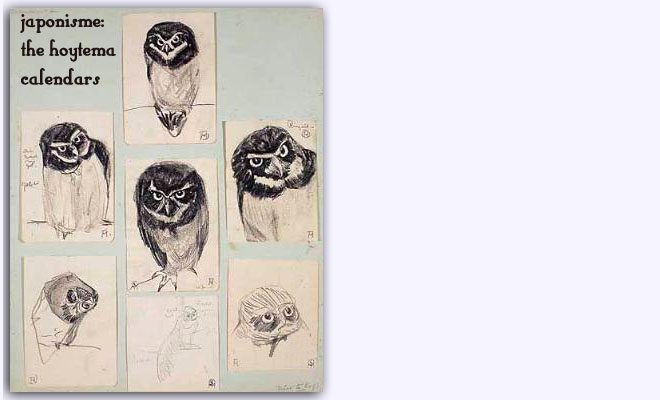well, i have decided to go about this differently. starting at beginning... theo van hoytema, in the early 1900s, made 17 calendars. each included a seasonal lithograph for each month, though the one for 1918 is sketchy as that was the year of hoytema's death.
of hoytema, ArtDaily says, "Theodoor van Hoytema, a Dutch painter, lithographer and designer, was born in The Hague. He made many watercolours and drawings of plants and animals, which clearly reveal his appreciation for Japanese prints: he often outlined the separate areas of flat color with ink, in imitation of such prints, and he could describe the characteristic attitudes of animals with a masterly economy of line. 1
i was going to wait until i had assembled every month for every year, but it's already taken me days and days, and will likely be multiples of that to come. I didn't want to wait that long before posting anything. plus, the entire run would have been a massive post.
so i'll do one year at a time. interestingly, the only one i have every month for is 1902, the first year they appeared, so i'll start with that. don't know yet if the rest will be in chronological order.
to my knowledge, this has never been done before; the complete set, or even anything like it, has certainly never before published online, and the only book i've found devoted to the subject is missing many months for nearly every year. additionally, i've had a very hard time digging up information on hoytema in english, so i've ordered a bunch of books from the library.* that way i can include more about the artist as i go on.
of hoytema, ArtDaily says, "Theodoor van Hoytema, a Dutch painter, lithographer and designer, was born in The Hague. He made many watercolours and drawings of plants and animals, which clearly reveal his appreciation for Japanese prints: he often outlined the separate areas of flat color with ink, in imitation of such prints, and he could describe the characteristic attitudes of animals with a masterly economy of line. 1
i was going to wait until i had assembled every month for every year, but it's already taken me days and days, and will likely be multiples of that to come. I didn't want to wait that long before posting anything. plus, the entire run would have been a massive post.
so i'll do one year at a time. interestingly, the only one i have every month for is 1902, the first year they appeared, so i'll start with that. don't know yet if the rest will be in chronological order.
to my knowledge, this has never been done before; the complete set, or even anything like it, has certainly never before published online, and the only book i've found devoted to the subject is missing many months for nearly every year. additionally, i've had a very hard time digging up information on hoytema in english, so i've ordered a bunch of books from the library.* that way i can include more about the artist as i go on.

























































